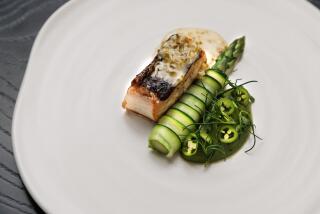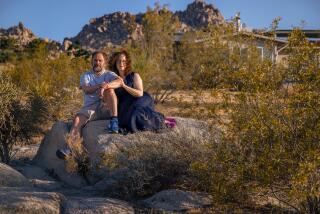This Easy Rider Isn’t a Man for All Terrain
- Share via
SAN DIEGO — I have these friends who are always after me to go with them to the desert and ride one of those contraptions called a dune buggy.
Wrong.
What they ride and where they ride it has never appealed to me. Give me blue skies and green lights . . . and pavement. Give me four doors, radial tires and a gas gauge that works, which, incidentally, I don’t happen to possess at the moment.
So what in the world was I doing down in Otay Mesa in the dirt and dust and debris west of Brown Field?
Going for a ride?
In that?
Danny Ashcraft was behind the wheel of one of those off-road things. I was to be his passenger. If only I could figure out how to get into it.
“Where’s the door handle?” I asked.
“There isn’t any,” he said. “You gotta crawl through the window.”
Being the sedan type, this didn’t play into my wheelhouse. I crawled through the window and found myself being strapped in like I was about to take off in a space shuttle. A helmet was slipped onto my head and I felt air coming into my left ear.
Air?
How about music?
Where’s the tape deck?
“There isn’t any,” he said. “But the horn’s over on your side.”
This was, I learned, a $150,000 vehicle. The engine cost $25,000 and the shocks maybe $20,000. Wheels and tires ran $500 each.
And the darned thing did not have a tape deck.
Ashcraft was at the wheel of Herzog Racing’s 1992 Ford Explorer. His next ride would be Thursday, when the Baja 1,000 begins in Ensenada. This would be a less-than-casual sojourn the length of Baja to La Paz.
I was along for the final testing.
Ashcraft, 41, who owns a machine shop in Carlsbad, would be one of the favorites in one of the fastest of 14 classes. He and codriver Dave Mason, 31, from Valley Center, won their class in 1990 and finished second last year only because they caught fire 40 miles from the finish.
“We’ll take it slow at the start,” Ashcraft said.
My head snapped backward as he took it slowly at the start.
“We’re going maybe two-thirds race speed,” he said later.
My knuckles were white.
“Ledge coming up,” he said.
And he accelerated.
Huh?
I go over speed bumps, which I hate, at maybe 3 m.p.h. This guy was accelerating as he approached a ledge.
We were airborne for an eternity or maybe three-tenths of a second. My stomach was in my throat. I realized why they asked if I really wanted to have lunch before the ride.
Ashcraft was talking to me via radio, even though he was two feet away. You don’t otherwise converse when this vehicle is roaring through ruts and gravel.
“How’s the gas mileage?” I asked, being ever practical.
“Oh, 2 1/2, 3 1/2 miles per gallon,” Ashcraft said.
“Plenty of gas stations down there, huh?” I assumed.
Eight, maybe nine fuel stops. B.F. Goodrich, one of Herzog’s sponsors, sends semi-truck down there to service its entries. These aren’t exactly convenience store operations, but they keep things rolling.
“We’re at Baja speed,” Ashcraft said.
“Funny,” I said. “The faster you go, the smoother it seems to get.”
In truth, we were literally flying over the rough spots.
“This car will go over almost anything,” he said.
I understood why $20,000 was invested in shocks. He was driving places it would be difficult to walk. And he was driving all-out.
And it was surprisingly comfortable.
However, it was obvious 1,038 miles of this kind of driving would be exhausting. Baja is full of surprises. Relax for a second and the race can be over. This is not like Indy with 500 miles of left turns on smooth pavement. This was climbing mountains, running beaches, swerving through trees and lurching down washes.
“When you run in Mexico,” Ashcraft said, “you have to be ready for anything.”
“When you see natives,” Mason said. “You hit the brakes. They build water pits after a jump or roll logs across the road. They try to trick you.”
“When they’re standing around watching,” Ashcraft said, “it’s not to see you race down a straightaway. They’re up to something.”
Given the natural obstacles alone, the perfect mode of transportation would be a bighorn sheep.
“It’s really tough in the dust at night,” said Mason, who will drive the second half of the race. “You can get lost in the silt beds.”
“It’s this deep,” Ashcraft said, holding his hands about two feet apart. “And it’s like talcum. You can drop a wrench in it and lose it. The dust gets into the air and into the car and you can’t see your hands on the wheel.”
Ashcraft pulled the car up next to the pit crew and I crawled out the window.
He started to tell me about the engine and I held up my hand.
“Hey,” I said, “I don’t know a carburetor from a hub cap. You start talking 4.8 liters and I bring out a corkscrew.”
I got into the family car, through the door, and turned on the tape deck. I inched ever so slowly across the moonscape back to the main road. I couldn’t wait to tell my friends I had run Baja. Sort of.
More to Read
Sign up for The Wild
We’ll help you find the best places to hike, bike and run, as well as the perfect silent spots for meditation and yoga.
You may occasionally receive promotional content from the Los Angeles Times.






